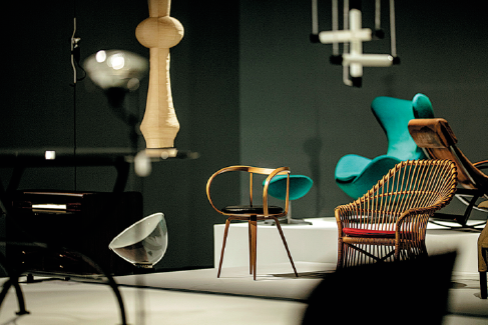



Exhibition showcases how industrial design has significantly changed lifestyles over a century, Lin Qi reports.
In the final scenes from Charlie Chaplin's satire The Great Dictator, he delivers a speech to the assembled crowd in the make-believe country of Tomania.
"More than machinery, we need humanity," goes a quote from Chaplin's speech in the film. Today, this same quote is being displayed at Design Utopia 1880-1980, an exhibition at the Tsinghua University Art Museum. The exhibition, until Aug 25, captures the critical development of design as an independent discipline and industry over a century.
The use of Chaplin's quote reveals the idea underpinning this display of 158 modern designs; that design gives people access to the benefits of industrial production and helps them to envision a creative and sustainable future, as well as serving human interests in a much more diverse way.
The designs on show, which are mostly furniture pieces, are from the Biagetti-Koenig Collection managed by Musei Italiani in Italy, presenting the evolution of Italian and international designs in industrial production.

In a video address at the exhibition's opening, curator Alessandro Guerriero says he has read through the exhibition catalog many times, and he feels that the exhibition is like "a long river" that includes a series of classic designs which were made in, and traveled to, different countries.
Guerriero says the exhibition is also like "a big, rich palette of tones", and every piece on show provides inspiration and suggestions for the future.
He adds that people would find that the exhibits provide graphical guidelines to art history, and a reflection of how philosophical hypotheses become facts at the exhibition.
Every exhibit is unique and the exhibition shows how different materials interact with technology, ideas and theories, so visitors will be amazed as they examine every piece of work on display.
Lu Xiaobo, dean of the Academy of Arts and Design at Tsinghua University, says several works on show are classic examples of what design students will learn in textbooks, and also show how artists and designers utilized new materials at the time to create a world of modernity. He also says the works introduced novel aesthetic values into people's daily lives by turning homes, workplaces and public venues into galleries to showcase different styles and innovative ideas.

One such iconic piece is Thonet Chair No. 14, created by German cabinetmaker Michael Thonet and is famously known as the "chair of chairs "in the world of design. Thonet's chair creation is known for its simple, elegant curves. It was the result of a new method Thonet developed to successfully steam and bend beechwood after years of experiments.
The light, comfortable and affordable chair is seen as an accomplishment of both artistry and technology. It could be disassembled and reassembled for the convenience of mass production and transportation.
After its launch in 1859, it became one of the best-selling chairs in the world in the decades that followed. It was widely used in coffee houses and restaurants. It was also depicted in French artist Henri de Toulouse-Lautrec's world famous painting At the Moulin Rouge. Luminaries including Albert Einstein and Pablo Picasso also sat on those chairs in file photos.
Swiss-French architect Le Corbusier was one of those who spoke highly of No. 14, saying that there "never was a better and more elegant design, and a more precisely crafted and practical item created".

The Design Utopia exhibition shows chairs as more popular objects of design than other furniture items. Apart from Chair No. 14, there are several other signature chairs that have made their mark in the history of modern design. These include the Red and Blue Chair and the Zig-Zag Chair by Dutch designer Gerrit Rietveld, the Willow Chair by Scottish artist Charles Rennie Mackintosh and the bright multicolored Proust Armchair by Italian designer Alessandro Mendini.
Tian Ni, a graduate of the Academy of Arts and Design, says she is enthralled to see so many iconic designs at the exhibition, which she only saw in books at school.
She says those who frequent furniture stores may find many of these designs familiar. When these furniture pieces were invented decades or even a century ago, they were considered avant-garde.
"They challenged people's conceptions of what an article of furniture should look like and what it should be made of," Tian says.

"What designers did was not to design a chair, a lamp or a desk in the traditional sense. They were boundless in creativity, and they tried to incorporate the developments in technology and materials into it. Their work forged innovative aesthetic values and ideas about the changing relationship between humankind and the environment."
The exhibition also shows how designers greatly changed people's lifestyles, just like what the late Italian designer Ettore Sottsass said, "I don't think I invented anything; I proposed a way of being."
Su Dan, deputy director of Tsinghua University Art Museum, says the exhibition is a collection of works showcasing the ideas of great people and technical inventions, how they brilliantly put ideas and inventions into practice, and how people seized opportunities with ideals, intelligence and willpower in an animated part of history.
If you have any problems with this article, please contact us at app@chinadaily.com.cn and we'll immediately get back to you.